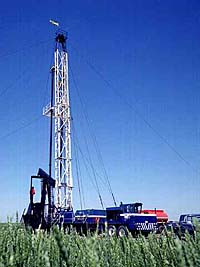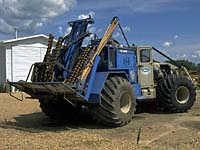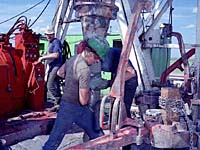
Description of Crude OilCrude oil is a mixture of many substances, mainly compounds of carbon and hydrogen, together with varying portions of sulphur. These complexes were produced through the decomposition of plant and animal remains under heat and pressure over millions of years. Their ultimate origin goes back through photosynthesis to solar energy. Crude oil is also referred to as petroleum, from the Greek word petra, meaning rock and the Latin word oleum meaning oil. Saskatchewan produced crude oil has a wide range of quality, varying from light sweet crude to heavy sour crude. From these, three types of crude oil is produced; heavy, medium and light gravity. All three types are produced in almost equal proportions.
Mining and Refining Crude OilIn Saskatchewan, oil is recovered from underground reserves in several ways:
The majority of the province's refining capacity is in Regina where Consumers' Co-operative Refineries Ltd. operates a 50,000 barrel per day conventional refinery. NewGrade Energy Inc., a joint venture by Consumers' Co-op and the Government of Saskatchewan, completed construction of a 55,000 barrel per day heavy oil upgrader in 1988. The Newgrade upgrader is currently operating at full capacity. The upgrader converts the heavy crude into a lighter, higher quality product, which is used as feedstock for the Co-op Refinery. A second heavy oil upgrader was built at Lloydminster, Saskatchewan in 1992. This bi-provincial upgrader is operated by Husky Oil and is sourcing equal amounts of heavy oil from Alberta and Saskatchewan. Current input to the upgrader is 55,000 barrels per day of heavy crude and 6,000 barrels per day of light "tops" from Husky's Lloydminster asphalt plant. Light synthetic crude is produced from the heavy crude. Over 500 people are employed, in total, at the upgraders.
Producers of Crude OilAny company can produce oil in Saskatchewan as long as it obeys the provincial laws and regulations governing its activity. Companies must acquire the petroleum rights from the Province of Saskatchewan or private individuals or companies. Approximately 75 per cent of oil and gas rights in Saskatchewan are held by the province with the remaining 25 per cent of the oil and gas rights being privately owned. There are over 400 oil and gas companies operating in Saskatchewan on behalf of more than 2,100 working interest owners. Saskatchewan had in excess of 21,000 wells listed as capable of oil production at the end of 1995 (approximately 16,000 active wells). There was an increase in drilling recorded in 1995 with at total of 1,778 oil wells drilled compared to the previous year. The oil produced in Saskatchewan is largely dependent upon one main pipeline system (Interprovincial Pipe Line) to transport it to market.
Uses for Crude Oil
About 24 per cent of Saskatchewan's production is currently used within the province. Approximately 63 per cent of Saskatchewan's production is exported to the United States. The remainder of Saskatchewan's production is sold in Eastern Canada with a minor amount of heavy oil sold in Alberta. Prices are largely determined by the crude oil market in Chicago. Direct and indirect employment associated with Saskatchewan's oil industry (excluding refining, upgrading, and natural gas activity) now accounts for over 12,000 jobs.
The Future: How Much is Left?It is estimated that approximately 80-85 per cent of Saskatchewan's oil potential has already been discovered. Therefore, a large part of the future of our industry is tied to improving recoveries from existing pools. A horizontal drilling technology significantly improves recovery rates and lowers operating costs for many reservoirs in Saskatchewan, particularly those in the heavy oil areas.
|



